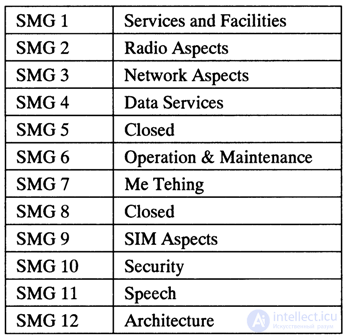Lecture
Communication standards are necessary to ensure compatibility of technical solutions offered by various equipment manufacturers, that is, to ensure the possibility and convenience of working on the common market for cellular mobile communication systems of all its participants - equipment manufacturers, service providers and operators.
The standardization issues in the field of communications and related areas are addressed by a large number of organizations - global, regional and national.
Note some of them related to the GSM standard:
- The International Telecommunications Union ITU (International Telecommunications Union), which has the ITU-T telecommunications standardization sector, is the successor to the International Telegraph and Telephony Advisory Committee (CCITT).
- International Organization of ISO Standards (International Standards Organization).
- European Telecommunications Standards Institute ETSI (European Telecommunications Standards Institute).
Each of the organizations listed above, like a number of many others not included in this list (other organizations will be listed as the material of the book is presented), has a clear structure and a clearly formulated range of tasks, and the work of these organizations is coordinated using the mechanism of interregional conferences on telecommunication standards.
Buy a repeater, watch prices
Consider the activities of ETSI, which developed the GSM standard. ETSI, established by the countries of the European Community in March 1988, is an interstate organization. In all ETSI publications devoted to the GSM standard, the main idea is consistently being that the GSM standard does not define how to build equipment, but defines in detail the interfaces and functions performed by this equipment. Thus, to the least possible extent, the initiative of designers and equipment manufacturing companies is limited, and cellular network operators are given the opportunity to purchase and use equipment from various manufacturers. The technical part of the ETSI, headed by the technical assembly, has 12 technical committees, including a special group on mobile systems - TCSMG (Technical Committee Special Mobile Group), which is responsible for the development of standards for GSM 900 and GSM 1800 cellular mobile communication systems [1.5 ].

The GSM 900 standard consists of more than 100 books (specifications) - GSM Technical Specifications, combined into 12 series, from 2 to 30 books in each series.
12 series of GSM technical specifications (GSM Technical Specifications) include [1.5, 1.6]:
01 General Description of a GSM PLMN
02 Services
03 Network Functions
04 MSoBSS Interface
05 Radio Path
06 Speech Processing Functions
07 Terminal Adaptation Functions
08 BSSoMSC Interface
09 Network Interworking
10 Service Interworking removed
11 Type Approval Procedures
12 Operation and Maintenance.
Wherein:
- Series 01 addresses common issues (terminology, classification of functions, phases of their implementations).
- Series 02: Services (detailed definition of all services provided).
- Series 03: Network functions (organization of the functioning of a cellular communication network).
- Series 04: Interface and protocols exchange.
- Series 05: Radio path (physical layer of the radio channel: multiplexing and multiple access, channel coding, modulation, synchronization).
- Series 06: Speech Coding.
- Series 07: Technical Adaptation Functions.
- Series 08: BSS Interface on MSC.
- Series 09: Intra-network interaction.
- Series 10: Service interactions when moving.
- Series 11: Types of approved procedures.
- Series 12: Management and Operation.
As an example, consider the largest in volume book-specification:
- Book 04.08: Level 3 of the mobile radio interface (about 450 pages).
- Book 09.02: Mobile Applications (application protocols between switches and databases) (more than 500 pages).
- Book 11.10: Requirements for a mobile station (more than 500 pages).
- Book 11.20: Base station requirements (over 400 pages).
The core of the GSM 1800 standard (DCS 1800) is the specification of the GSM 900 standard. Added to them are 14 additional specifications (delta specifications) that define the differences between GSM 1800 and GSM 900.
For example:
- Book 02.06 - DCS: definition of power classes of mobile stations.
- Book 02.11 - DSC: the definition of national roaming.
- Book 03.12 - DSC: modification of location registration procedure for national roaming, etc.
In conclusion of this paragraph it should be noted that it gives only a brief acquaintance with the GSM technical specification (with part of the technical specifications given in English), which allows, if necessary, a more in-depth study of the GSM standard on the books-specifications.
Comments
To leave a comment
GSM Basics
Terms: GSM Basics